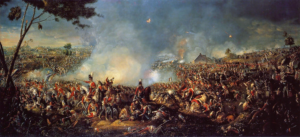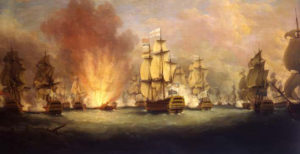On the Same Page
Reader’s Guide
Persuasion
Chapters
► Jane Austen
► Janeites
► Regency Era
► Lyme Regis
► Bath
► The Napoleonic Wars
► Romantic Poets
► Books About or Inspired by Austen and Her Works
Jane Austen
(December 16, 1775 – July 18, 1817)
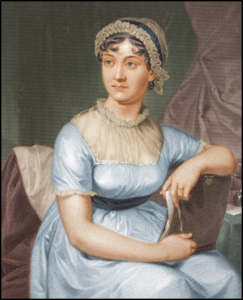 Jane Austen was the last of seven children born within ten years to George Austen and the former Cassandra Leigh. While the Austens were an old and respected family, their wealth had steadily diminished over the generations leaving George in poverty. He became a clergyman to support his family and additionally taught three or four young men privately who boarded with the family. Between the two incomes, the family status was modest at best.
Jane Austen was the last of seven children born within ten years to George Austen and the former Cassandra Leigh. While the Austens were an old and respected family, their wealth had steadily diminished over the generations leaving George in poverty. He became a clergyman to support his family and additionally taught three or four young men privately who boarded with the family. Between the two incomes, the family status was modest at best.
Jane and her sister Cassandra had little formal education. In 1783, the girls were sent to study with Mrs. Ann Cawley in Oxford. Jane was really too young to be sent away for schooling, but whatever Cassandra did, Jane did as well. As their mother said, “If Cassandra’s head had been going to be cut off, Jane would have hers cut off too.” The girls returned to their family at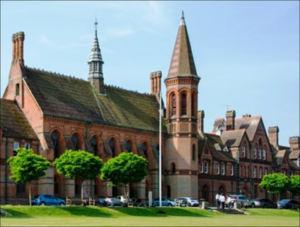 Steventon Rectory in Hampshire a short time later suffering from typhus. Jane nearly died. During the winter of 1785-86, they had a full year at the Reading Abbey Girl’s School under Mrs. LaTournelle who had a cork leg and instilled a love of theatre. Unfortunately, the Austens were unable to pay for the school’s fees after that year. Jane never left home again.
Steventon Rectory in Hampshire a short time later suffering from typhus. Jane nearly died. During the winter of 1785-86, they had a full year at the Reading Abbey Girl’s School under Mrs. LaTournelle who had a cork leg and instilled a love of theatre. Unfortunately, the Austens were unable to pay for the school’s fees after that year. Jane never left home again.
She returned with a love of theatricals which the family performed in the rectory barn. They staged popular plays of the time, mainly comedies. In the repertoire were three short plays which Jane wrote in her late teens. She also began writing poems and stories for her family’s entertainment in her tiny handwriting. Many evenings found Jane reading novels to the family, sometimes of her own creation.
In her late teens, Jane completed the novel Lady Susan which stands out from her other works with a protagonist who is manipulative, abusive, and basically a sexual predator. The character may have been inspired by stories told by her new sister-in-law. Eliza deFeullide married her favorite brother Henry after fleeing France and her first husband’s execution by guillotine.
More novels followed. In the early 1790’s she read Elinor and Marianne, which we know as Sense and Sensibility, to her family. In the mid-1790’s, she wrote First Impressions (Pride and Prejudice), and in the late-1790’s Susan, (Northanger Abbey) a satire on the popular gothic style novels of the time.
During the late 1790’s, George Austen attempted, without Jane’s knowledge, to get Pride and Prejudice published but could find no takers. In 1803, Henry sold the copyright to Northanger Abbey for $10 but the publisher didn’t do anything with the title. It may seem odd to us that Jane never made these attempts herself. However, at the time, a woman was legally not allowed to enter into a contract. In fact, it was rare to have a woman’s name on a book at all since such notoriety was considered demeaning to her femininity as well as the reputation of her family.
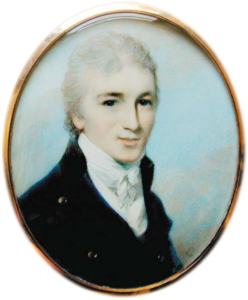 In 1796, Jane wrote to Cassandra that she expected a proposal that evening from Tom Lefroy with whom she’d recently been spending a great deal of time. The two seemed well suited. Some have speculated that their relationship was the basis for Elizabeth Bennett and Mr. Darcy in Pride and Prejudice with the gender of the personalities swapped. Unfortunately, Lefroy was in a strained financial situation much like the Austen family, and Jane confided to Cassandra that she felt compelled to reject his proposal.
In 1796, Jane wrote to Cassandra that she expected a proposal that evening from Tom Lefroy with whom she’d recently been spending a great deal of time. The two seemed well suited. Some have speculated that their relationship was the basis for Elizabeth Bennett and Mr. Darcy in Pride and Prejudice with the gender of the personalities swapped. Unfortunately, Lefroy was in a strained financial situation much like the Austen family, and Jane confided to Cassandra that she felt compelled to reject his proposal.
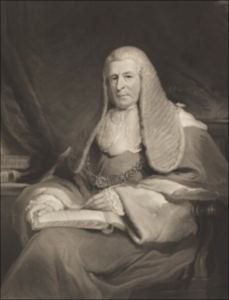 Contact between the two abruptly ended. After Lefroy, other suitors never quite measured up. It is interesting to note that his circumstances did eventually improve. He became a judge and later a member of parliament.
Contact between the two abruptly ended. After Lefroy, other suitors never quite measured up. It is interesting to note that his circumstances did eventually improve. He became a judge and later a member of parliament.
In 1801, George Austen retired from his clergy post and took the family to Bath. Jane did little writing during the four years that she resided in the fashionable city. Many say the lack of creative output was due to her unhappiness in Bath. Others speculate that she enjoyed Bath and had little time to write due to a busy social life. Absolutely no correspondence has survived from this time to give us hints. She began a novel called The Watsons about a poor clergyman and his four unmarried daughters but never completed it.
It was during this time that Jane accepted a proposal of marriage from Harris Bigg-Wither. The man was well off but known for being aggressive and tactless. The decision was quickly regretted, and she broke the engagement the next morning.
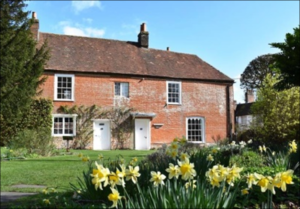 George Austen died suddenly in 1805 leaving his widow and two unmarried daughters without support. During the next years, the trio lived with various relations in Bath, Steventon, Godersham, Worthing, and Southampton. In 1809, they were finally able to settle in Chawton Cottage near Edward, the eldest son.
George Austen died suddenly in 1805 leaving his widow and two unmarried daughters without support. During the next years, the trio lived with various relations in Bath, Steventon, Godersham, Worthing, and Southampton. In 1809, they were finally able to settle in Chawton Cottage near Edward, the eldest son.
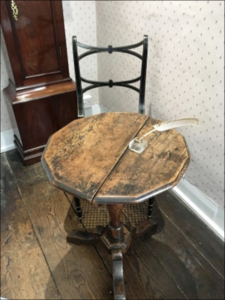 The group did not socialize outside of the family, spending their time reading, writing, and working with the poor.
The group did not socialize outside of the family, spending their time reading, writing, and working with the poor.
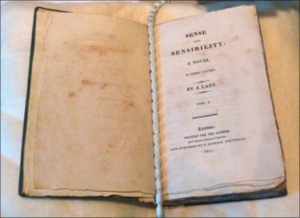 In Chawton, she began earnestly writing again and was finally able to see her works in print, beginning with her earlier novels. Sense and Sensibility was the first to be published in 1811 followed by Pride and Prejudice in 1813, Mansfield Park in 1814 and Emma in 1815.
In Chawton, she began earnestly writing again and was finally able to see her works in print, beginning with her earlier novels. Sense and Sensibility was the first to be published in 1811 followed by Pride and Prejudice in 1813, Mansfield Park in 1814 and Emma in 1815.
In 1816, she began to feel unwell. She had suffered from joint pain, but that year saw a slow, irregular deterioration. She had difficulty walking and lacked energy. She was able to complete The Elliots (Persuasion) in 1816 and began The Brothers (Sandition.) Persuasion and Northanger Abbey were published posthumously. Sandition was unpublished until 1925.
By the spring of 1817, Jane was completely bedridden and in continual and horrible pain. It was said that she welcomed death, which came in July. Her cause of death is not decisively known. Speculations have ranged from Hodgkin’s lymphoma to arsenic poisoning. Currently, the most popular theory is Addison’s disease, which stops the body from making critical hormones.
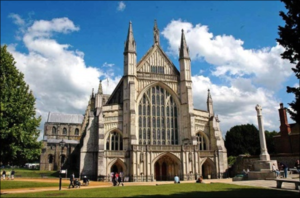 Her brother Henry used his clerical connections to have her buried in Winchester Cathedral. She was interred under the floor of the north aisle of the nave with a simple gravestone and only four
Her brother Henry used his clerical connections to have her buried in Winchester Cathedral. She was interred under the floor of the north aisle of the nave with a simple gravestone and only four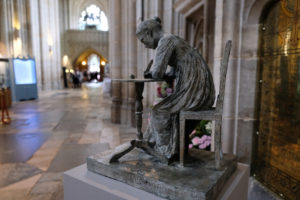
attending the funeral, her brothers Edward, Francis, Henry, and a nephew, James. A wall plaque was added in 1870 making mention of her writing and a memorial window in 1900.
After her death, her family fostered the image of “good quiet Aunt Jane” who embraced domestic life and doted on her family. It’s uncertain how accurate this portrayal is. Jane’s sister Cassandra who possessed most of her correspondence is known to have burned two thirds of Jane’s letters and cut extensive passages from others leaving large gaps in Jane’s history. For example, no letters survive from 1801-1804, her primary years in Bath. Her nephew destroyed more and future generations sanitized accounts further. While family accounts tell of an easy, amusing intellectual home with open political and social discussions, some scholars have read deep disappointment and an unpleasant family life into the created blanks.
 All of Jane Austen’s novels, though published anonymously, gained a respectable contemporary following. The Prince Regent enjoyed them enough to keep a complete set in each of his residences and there were pirated translations circulating throughout France. Two hundred years after their appearance, their popularity continues to grow. Austen’s novels allow a
All of Jane Austen’s novels, though published anonymously, gained a respectable contemporary following. The Prince Regent enjoyed them enough to keep a complete set in each of his residences and there were pirated translations circulating throughout France. Two hundred years after their appearance, their popularity continues to grow. Austen’s novels allow a  detailed and specific glimpse into a world very different from our own, but the underlying humanity and interweaving relationships still feel very real and modern in their basic struggles.
detailed and specific glimpse into a world very different from our own, but the underlying humanity and interweaving relationships still feel very real and modern in their basic struggles. 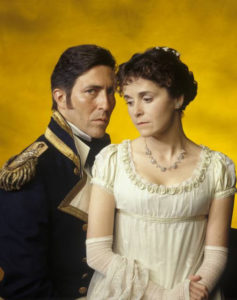 That’s probably why her stories are interpreted so often and so widely. Contemporary reimaginings abound.
That’s probably why her stories are interpreted so often and so widely. Contemporary reimaginings abound.
Long live Jane!
Janeites
“Janeite” is a popular term used to describe an extreme fan of Jane Austen and her works. Claudia Johnson, an Austen scholar, defines it as “the self-consciously idolatrous enthusiasm for ‘Jane’ and every detail relative to her.”
 While many consider the label to have recent origins, it actually goes much further back and travels far from our common assumption of female fervor. In 1926, Rudyard Kipling published a short story “The Janeites” about a group of World War I soldiers clinging to the novels of Austen as a model normality. Indeed in the early 20th century “Janeiteism” was “principally a male enthusiasm” claims Johson. Upon closer examination, the term goes back decades further, coined by George Saintsbury in an introduction to an 1894 republication of Pride and Prejudice.
While many consider the label to have recent origins, it actually goes much further back and travels far from our common assumption of female fervor. In 1926, Rudyard Kipling published a short story “The Janeites” about a group of World War I soldiers clinging to the novels of Austen as a model normality. Indeed in the early 20th century “Janeiteism” was “principally a male enthusiasm” claims Johson. Upon closer examination, the term goes back decades further, coined by George Saintsbury in an introduction to an 1894 republication of Pride and Prejudice.
Regency Era
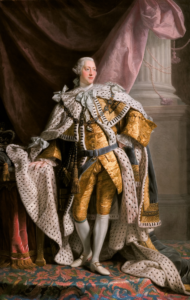 For a non-Brit, terms like Georgian style architecture and Regency era dress may cause slight confusion. The Georgian era lasted from 1714 to 1830’s during the reigns of four consecutive King Georges. A small subset of this time period from 1811 to 1820 while still part of the Georgian era is a subset sometimes referred to as the Regency era. During these nine years, King George III was deemed too ill to effectively reign. Therefore George IV, the Prince of Wales, acted as regent ruling in behalf of his father.
For a non-Brit, terms like Georgian style architecture and Regency era dress may cause slight confusion. The Georgian era lasted from 1714 to 1830’s during the reigns of four consecutive King Georges. A small subset of this time period from 1811 to 1820 while still part of the Georgian era is a subset sometimes referred to as the Regency era. During these nine years, King George III was deemed too ill to effectively reign. Therefore George IV, the Prince of Wales, acted as regent ruling in behalf of his father.
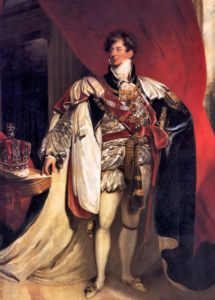 George IV loved fashion and elegance and while war with Napoleon was waging, he created lavish residences such as the Carleton House and the Indian inspired Brighton Pavilion as well as extravagant social events which drained the county’s coffers. His personal habits were also defined by excesses and the prestige of the monarchy suffered during his reign.
George IV loved fashion and elegance and while war with Napoleon was waging, he created lavish residences such as the Carleton House and the Indian inspired Brighton Pavilion as well as extravagant social events which drained the county’s coffers. His personal habits were also defined by excesses and the prestige of the monarchy suffered during his reign.
Lyme Regis
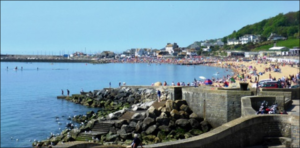 The small resort community of Lyme Regis sits on the southern coast of England in West Dorset on Lyme Bay. It became an important port in Saxon times.
The small resort community of Lyme Regis sits on the southern coast of England in West Dorset on Lyme Bay. It became an important port in Saxon times.
 The first documentation of its harbour wall known as The Cobb was a note in 1328 that it had been damaged in a storm. No one knows for sure exactly how long this artificial harbor and breakwater have been in existence.
The first documentation of its harbour wall known as The Cobb was a note in 1328 that it had been damaged in a storm. No one knows for sure exactly how long this artificial harbor and breakwater have been in existence. 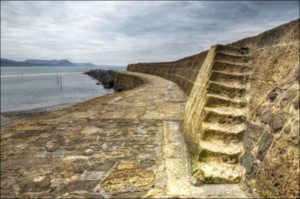 The Cobb figures prominently in Persuasion as well as John Fowles novel (and it’s film adaptation) The French Lieutenant’s Woman.
The Cobb figures prominently in Persuasion as well as John Fowles novel (and it’s film adaptation) The French Lieutenant’s Woman.
 The area around Lyme Regis is frequently referred to as the Jurassic Coast for its wealth of fossils. Today, it’s most famous resident in history would likely be Mary Anning, 1799-1847.
The area around Lyme Regis is frequently referred to as the Jurassic Coast for its wealth of fossils. Today, it’s most famous resident in history would likely be Mary Anning, 1799-1847. 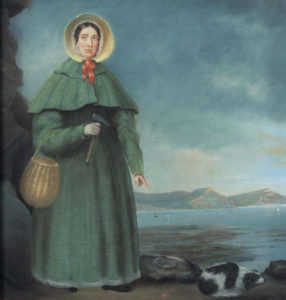 Though largely ignored in her lifetime, Anning discovered the first complete ichthyosaur skeleton, the first two nearly complete plesiosaurs, the first pterosaur outside of Germany, the first to correctly identify coprolites, and on, and on. Dismissed scientifically because of her gender, she made her living selling the smaller fossils which were plentiful on the local beaches. Many speculate that the tongue twister, “She sells sea shells by the sea shore,” was inspired by Mary Anning.
Though largely ignored in her lifetime, Anning discovered the first complete ichthyosaur skeleton, the first two nearly complete plesiosaurs, the first pterosaur outside of Germany, the first to correctly identify coprolites, and on, and on. Dismissed scientifically because of her gender, she made her living selling the smaller fossils which were plentiful on the local beaches. Many speculate that the tongue twister, “She sells sea shells by the sea shore,” was inspired by Mary Anning.
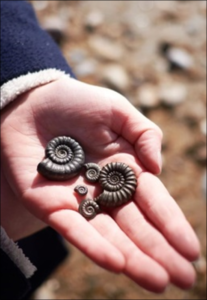 Fossils are still plentiful especially on the popular Ammonite beach were tourists gather the spiral shell fossils of widely varying sizes.
Fossils are still plentiful especially on the popular Ammonite beach were tourists gather the spiral shell fossils of widely varying sizes. The town celebrates an annual fossil festival.
The town celebrates an annual fossil festival.
Bath
 Two Austen novels, Northanger Abbey and Persuasion, are partially set in the city of Bath. The town has ancient roots only partially understood during Austen’s time. All of its significant reincarnations are tied to its thermal springs.
Two Austen novels, Northanger Abbey and Persuasion, are partially set in the city of Bath. The town has ancient roots only partially understood during Austen’s time. All of its significant reincarnations are tied to its thermal springs.
Around 60 A. D., the Romans constructed a temple on the site which was previously used as a place of worship by the Celt. Known as Aquae Sulis, Sulis being the Celtic goddess of wisdom which the Romans associated with their goddess Minerva, the complex was continually enlarged for the next three hundred years. After the Roman departure, the temple complex fell into disrepair and eventually lost completely due to silting, flooding, and looting on the worked stones.
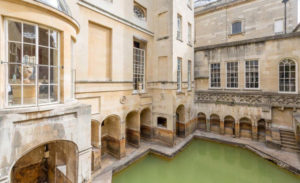 In the 1100’s another resort for the curative waters were constructed known as the King’s Spring. The Queen’s Bath was constructed just to the south in the 1500’s.
In the 1100’s another resort for the curative waters were constructed known as the King’s Spring. The Queen’s Bath was constructed just to the south in the 1500’s.
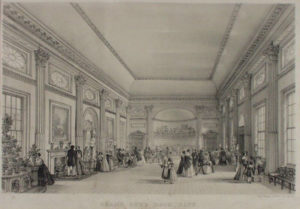 During the early 1700’s, the town began another renovation. This time the focus was not on submersion in the waters but rather ingestion of the waters. The first incarnation of The Grand Pump Room was completed in 1706 where the public could “take the waters,” stroll, and socialize. In the last decades of the 1700’s the town became highly fashionable and virtually had a complete overhaul to reflect the trends of the times. During a renovation of The Grand Pump Room and construction of an adjoining concert hall, the foundations of the old Roman baths were discovered. It was close to a century
During the early 1700’s, the town began another renovation. This time the focus was not on submersion in the waters but rather ingestion of the waters. The first incarnation of The Grand Pump Room was completed in 1706 where the public could “take the waters,” stroll, and socialize. In the last decades of the 1700’s the town became highly fashionable and virtually had a complete overhaul to reflect the trends of the times. During a renovation of The Grand Pump Room and construction of an adjoining concert hall, the foundations of the old Roman baths were discovered. It was close to a century 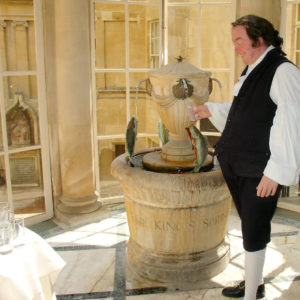 before archeologists began excavations and little was known about the old baths and complex during Austen’s time. The current entrance to the Roman baths and museum are at street level through the former concert hall with the baths themselves descending multiple levels below.
before archeologists began excavations and little was known about the old baths and complex during Austen’s time. The current entrance to the Roman baths and museum are at street level through the former concert hall with the baths themselves descending multiple levels below.
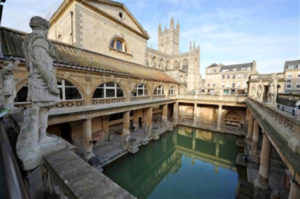 With the exception of the ancient baths, the main attractions of today’s Bath are very similar to what Austen and her characters would have experienced.
With the exception of the ancient baths, the main attractions of today’s Bath are very similar to what Austen and her characters would have experienced.
 Being famous walkers, Austen and her literary creations would undoubtedly have taken in St. James Park, now known as the Parade Gardens, a riverside park featuring sculptures, topiaries, and venues for intimate outdoor concerts.
Being famous walkers, Austen and her literary creations would undoubtedly have taken in St. James Park, now known as the Parade Gardens, a riverside park featuring sculptures, topiaries, and venues for intimate outdoor concerts.
 Two significant architectural landmarks are also largely unchanged from Austen’s time. The Royal Crescent is a half circle of high end town houses fronted by an expanse of private lawn. It’s an imposing site. Nearby, you’ll find the similar homes of the Circus considered the pinnacle of Georgian era style.
Two significant architectural landmarks are also largely unchanged from Austen’s time. The Royal Crescent is a half circle of high end town houses fronted by an expanse of private lawn. It’s an imposing site. Nearby, you’ll find the similar homes of the Circus considered the pinnacle of Georgian era style.
 Bath Abbey was founded in the 600’s with major renovations in the 900’s, 1100’s, 1500’s and finally in 1860.
Bath Abbey was founded in the 600’s with major renovations in the 900’s, 1100’s, 1500’s and finally in 1860.
 Our final stop on the Bath tour will be the River Avon with the distinctive Pulteney Bridge and weir. The bridge, completed in 1774, is unusual in that it houses businesses continuously on both sides of its length. Having afternoon cream tea in a bridge shop, one can look down over the river and the historic Pulteney Weir. A weir, a low dam built to avoid flooding, has been in place at this site since 1603. Enthusiasts of the film Les Miserables may recognize it as the setting for Javert’s ultimate end.
Our final stop on the Bath tour will be the River Avon with the distinctive Pulteney Bridge and weir. The bridge, completed in 1774, is unusual in that it houses businesses continuously on both sides of its length. Having afternoon cream tea in a bridge shop, one can look down over the river and the historic Pulteney Weir. A weir, a low dam built to avoid flooding, has been in place at this site since 1603. Enthusiasts of the film Les Miserables may recognize it as the setting for Javert’s ultimate end.
The Napoleonic Wars
Following Napoleon’s rise to power in France, he turned his attention to the rest of Europe. His efforts led him to conquer what is now Egypt, Belgium, Holland, Italy, Austria, and Germany. Further campaigns led him into conflict with Spain and Russia, though those countries gave him much more difficulty using tactics such as guerrilla warfare in Spain and the famed scorched earth warfare in Russia which earned its name as the retreating Russians burned anything the French could have used to sustain themselves. From the later of these conflicts 600,000 French soldiers never returned home.
Of course, even with all the warfare in Europe proper, France’s number one enemy was Britain. France was constantly trying to find a way to get at Britain. It was determined early in the Napoleonic Wars that Britain held mastery of the seas. France found ways to hamper their opponent such as trying to embargo trade with Britain with all continental nations. The British Navy, however, attacked the blockade with great gusto whenever possible. The wars made heroes and fortunes for the victorious British seamen.
In the end, Napoleon and his Grand Armée were defeated and Napoleon exiled. Of course, it took more than once for the exile to stick. Napoleon escaped the island where he was banished, returned, and for one last grand attempt at dominance before at last suffering his famous defeat at Waterloo and being exiled permanently to the Isle of Saint Helena.
Romantic Poets
 Anyone can write a love poem, but to be defined as a romantic poet one had to have lived and written in the romantic period. The Romantic period stretched from about 1800 to 1850, though it is much more than a section of years that define Romanticism. Romanticism held a strong focus on emotion, on individualism, on all things past, and on nature. It extended far beyond poetry and elements of its influence can be found in artwork, music, literature, and even chess. It was the poet William Wordsworth who summed up the Romantic era by saying it could be defined as “the spontaneous overflow of powerful feelings.”
Anyone can write a love poem, but to be defined as a romantic poet one had to have lived and written in the romantic period. The Romantic period stretched from about 1800 to 1850, though it is much more than a section of years that define Romanticism. Romanticism held a strong focus on emotion, on individualism, on all things past, and on nature. It extended far beyond poetry and elements of its influence can be found in artwork, music, literature, and even chess. It was the poet William Wordsworth who summed up the Romantic era by saying it could be defined as “the spontaneous overflow of powerful feelings.”
Of course, William Wordsworth (who wrote The Prelude and The Daffodils) was only one of the poets of the era. Other considered among the “Big Six” were Samuel Taylor Coleridge, who wrote The Rime of the Ancient Mariner and Kubla Khan; John Keats, the author of poems such as Ode to a Nightingale and Sleep and Poetry; William Blake (The Tyger, The Lamb, and Songs of Innocence and Experience); 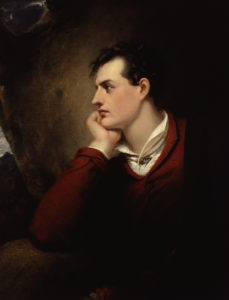 George Gordon Byron, better known as Lord Byron (Don Juan and Childe Harold’s Pilgrimage); and Percy Shelly (Ozymandias, Ode to the West Wind, and The Cloud), Of course he can’t forget his wife Mary Shelly known for more for the novel Frankenstein rather than her poetry.
George Gordon Byron, better known as Lord Byron (Don Juan and Childe Harold’s Pilgrimage); and Percy Shelly (Ozymandias, Ode to the West Wind, and The Cloud), Of course he can’t forget his wife Mary Shelly known for more for the novel Frankenstein rather than her poetry.
The Big Six were huge, the rock stars of their era, complete with the influence, notoriety, and fanatical followers. Many took advantage of their fame. Lord Byron in particular was noted for his dozens of lady friends and lovers.
Books About or Inspired by Austen and Her Works
A Jane Austen Education by William Deresiewicz
A Weekend with Mr. Darcy by Victoria Connelly
An Assembly Such As This by Pamela Aidan
Austenland by Shannon Hale
Ayesha at Last by Uzma Jalaluddin
Bridget Jones’s Diary by Helen Fielding
Confessions of a Jane Austen Addict by Laurie Viera Rigler
Dear Mr. Knightley by Katherine Reay
Death Comes to Pemberley by P.D. James
Definitely Not Mr. Darcy by Karen Doornebos
Eligible by Curtis Sittenfeld
Emma by Alexander McCall-Smith
First Impressions by Debra White Smith
For Darkness Shows the Stars by Diana Peterfreund
Heartstone by Elle Katherine White
Jane and the Unpleasantness at Scargrave Manor by Stephanie Barron
Jane Austen at Home by Lucy Worsley
Jane Austen in Scarsdale by Paula Marantz Cohen
Jane Austen: A Life by Claire Tomalin
Jane Austen: A Life Revealed by Catherine Reef
Jane Austen’s Charlotte by Julia Barrett
Jane Austen’s England by Roy Adkins
Jane Austen’s Guide to Dating by Lauren Henderson
Jane Bites Back by Michael Thomas Ford
Jane of Austin by Hillary Manton Lodge
Just Jane by Nancy Moser
Longbourn by Jo Baker
Mr. Darcy Takes a Wife by Linda Berdoll
Mr. Darcy’s Diary by Amanda Grange
Mr. Darcy’s Obsession by Abigail Reynolds
Mr. Darcy’s Secret by Jane Odiwe
Prejudice Meets Pride by Rachael Anderson
Pride & Popularity by Jenni James
Pride and Prescience: Or, A Truth Universally Acknowledged by Carrie Bebris
Pride by Ibi Zoboi
Pride, Prejudice, and Other Flavors by Sonali Dev
Pride, Prejudice, and Zombies by Seth Grahame-Smith
Prom & Prejudice by Elizabeth Eulberg
Seeking Mansfield by Kate Watson
Sense & Sensibility by Joanna Trollope
Sense and Sensibility and Sea Monsters by Ben H. Winters
The Dashwood Sisters Tell All by Beth Pattillo
The Jane Austen Book Club by Karen Joy Fowler
The Jane Austen Handbook by Margaret C. Sullivan
The Jane Austen Project by Kathleen A. Flynn
The Jane Austen Society by Natalie Jenner
The Lost Memoirs of Jane Austen by Syrie James
The Other Mr. Darcy by Monica Fairview
The Real Jane Austen by Paula Byrne
Two Shall Become One by Sharon Lathan
DISCUSSION QUESTIONS
-
What does the opening of the novel tell you about both its characters and the condition of Britain in 1815?
-
How does Sir Walter interact with his three daughters, Elizabeth, Anne, and Mary? Do you find the attitudes of Anne’s family to be funny or irritating?
-
What do Sir Walter’s fiscal problems suggest about the condition of the upper class and aristocracy in Britain?
-
What does the navy represent in the novel? Compare and contrast the two worlds of the novel, the aristocracy and upper class on one hand and the British navy on the other.
-
With their newfound wealth, both Captain Wentworth and Admiral Croft are able to join the upper ranks of English society. What other options are available for social mobility? What does Austen’s opinion of this appear to be?
-
Anne believes she was right to be “persuaded” by Lady Russell not to marry Captain Wentworth when he proposed earlier. Explain her reasoning. Do you agree with her? What are the results of eight years of waiting for Anne? For Wentworth?
-
When Anne meets Captain Benwick in Lyme, what draws the two together? Were you expecting a romance to develop between the two?
-
How does Wentworth react to Louisa’s fall? What does he begin to realize about Louisa . . . and Anne?
-
Captain Wentworth has doubts about the marriage of Captain Benwick and Louisa Musgrove. How do you rate their chances of happiness?
-
Describe the kind of marriage that Admiral and Mrs. Croft seem to have. How do they view one another? How does their marriage differ from the other couples? Do you think the Croft’s relationship is typical of the era?
-
Mrs. Clay is a destitute widow with no beauty, the sort of character that Austen, in other books, might be sympathetic to. Do you find her so? Why or why not?
-
What does Anne’s relationship with Mrs. Smith tell you about her?
-
Mrs. Smith allows Anne to come perilously close to a disastrous marriage. Do you find this forgivable?
-
In Bath, Anne believes Mr. Elliot is interested in her sister Elizabeth and hopes that he might not be “to nice, or too observant.” What does she mean? When he turns his attentions toward Anne, what makes her uncertain of his sincerity?
-
Captain Harville claims men do not quickly forget about the women they love while Anne claims the same for women. Do you believe men and women differ in their capacities to love and in remaining true to the one they love? Did she mean for Wentworth to overhear the conversation? What does she say that influences Wentworth?
-
Captain Wentworth and Anne are constantly in each other’s company. What keeps them from speaking honestly to each other?
-
Is Anne Elliot a passive or an active character? Consider her actions connected with leaving Kellynch, the stay in Lyme Regis, the concert in Bath, and reading Wentworth’s letter.
-
Does Anne go through the growth that Austen’s other heroines do?
-
Does Wentworth change? How is he shown to be well suited to Anne?
-
Why is this novel set in so many different locations? What do these places represent?
-
The characters are subject to different types of persuasion. Who is persuaded by what?
-
In all of her novels, Austen casts a gentle, satirical eye on society. In Persuasion, her gaze seems more critical: what might she be saying in this work?
-
In a letter, Austen described Anne Elliot as “almost too good for me.” How do you see the heroine of this novel?
-
Austen wrote Persuasion as her health was failing, hurrying to finish it before her death. Do you find the novel carries any sense of urgency, sentimentality, or any other indication of what the author herself was going through?
Download the Reader’s Guide
(PDF Download)
Regular Hours of Operation
- Monday: 9:00 am – 6:00 pm
- Tuesday - Wednesday: 9:00 am – 8:00 pm
- Thursday: 11:00 am – 8:00 pm
- Friday: 10:00 am – 6:00 pm
- Saturday: 10:00 am – 2:00 pm
- Sunday: CLOSED
Closures in 2025
- January 1 – New Year’s Day
- January 20 – Martin Luther King, Jr., Day
- February 17 – Presidents Day
- March 28 – Staff Development Day
- April 5 – Building Maintenance
- May 24-26 – Memorial Day
- June 19 – Juneteenth
- July 4-5 – Independence Day
- August 30-September 1 – Labor Day
- September 19 – Staff Development Day
- October 4 – Building Maintenance
- November 11 – Veterans Day
- November 26 – Closing at 5:00 pm
- November 27-29 – Thanksgiving
- December 24-26 – Christmas
- December 31 – New Year’s Eve
- January 1, 2026 – New Year’s Day
Address
73 North Center
Rexburg, Idaho 83440
We are located on Center Street, just north of Main Street, by the Historic Rexburg Tabernacle.
Contact Us
(208) 356-3461
24 Hour Phone Renewal: (208) 356-6658
askmadisonlibrary@madisonlib.org

